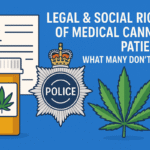Medical Cannabis vs. Diazepam for Pain Relief

Many people living with chronic pain are searching for treatments that offer effective relief without unpleasant side effects. Two options that are sometimes considered are medical cannabis and diazepam. Although both have been used in medical settings, their mechanisms, benefits and drawbacks are very different. Understanding these differences can help you make an informed decision about your own care.
How medical cannabis and diazepam work
Medical cannabis contains compounds such as THC and CBD which interact with the body’s endocannabinoid system. This system plays a key role in regulating pain perception, inflammation and mood. By working with the body’s natural pathways, medical cannabis can help reduce pain signals and improve overall comfort.
Diazepam, on the other hand, is a benzodiazepine. It was originally developed as an anti-anxiety and muscle-relaxant medication. While it may help with short-term muscle spasms or anxiety-related pain, it does not directly target pain pathways in the same way that medical cannabis does.
Effectiveness for pain relief
Research suggests that medical cannabis can provide significant relief for a range of chronic pain conditions, including neuropathic pain, arthritis and fibromyalgia. Many patients report not only reduced pain but also improved sleep and quality of life.
Diazepam is not primarily prescribed for pain. Its benefits in this area are generally indirect and limited to muscle tension or stress-related discomfort. Long-term use is not usually recommended, as tolerance can develop and effectiveness may decline.
Side effects and safety
Medical cannabis, when prescribed and monitored by a healthcare professional, has a fairly favourable safety profile. Common side effects such as mild drowsiness or dry mouth often diminish as the body adjusts. Importantly, it is not associated with the same high risk of dependency seen in many sedative medications.
Diazepam carries a well-documented risk of dependence, withdrawal symptoms and cognitive impairments with prolonged use. Even short-term use can cause drowsiness, dizziness and decreased coordination. These side effects can limit daily activities and may increase the risk of accidents.
Long-term management
Chronic pain requires ongoing management. Medical cannabis can be tailored to the individual through different strains, ratios of cannabinoids and delivery methods such as oils, capsules or vapourisers. This flexibility allows patients to identify a regimen that works best for them.
Diazepam offers little flexibility in this regard. Because of its dependence potential, it is usually prescribed only for brief periods. This limitation makes it less suitable for ongoing pain management.
Quality of life benefits
Patients who use medical cannabis frequently report not just pain relief but also improvements in mood, sleep, and overall wellbeing. Because it works with the body’s natural systems, it can support a more balanced approach to health rather than simply masking symptoms.
Diazepam may calm anxiety or relax muscles but often at the expense of alertness and mental clarity. Over time, these effects can interfere with work, driving and other daily responsibilities.
Conclusion
While both medical cannabis and diazepam have roles in medicine, their suitability for pain relief differs greatly. Medical cannabis directly targets the body’s pain and inflammation systems, offers customisable treatment options, and carries a lower risk of dependence. Diazepam may help in the short term for certain types of discomfort but is not a sustainable solution for chronic pain.
For individuals looking for effective, safer long-term relief, medical cannabis prescribed by qualified professionals provides a promising and evidence-based option.


